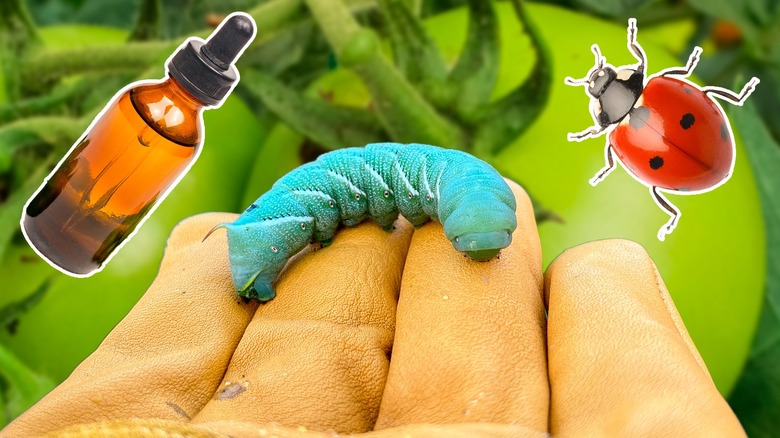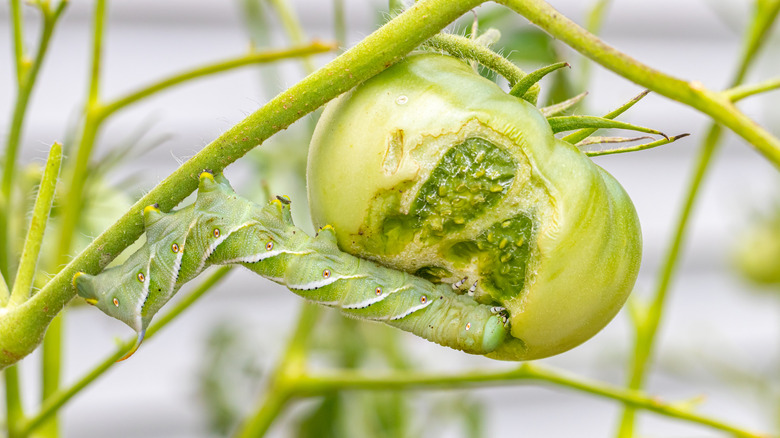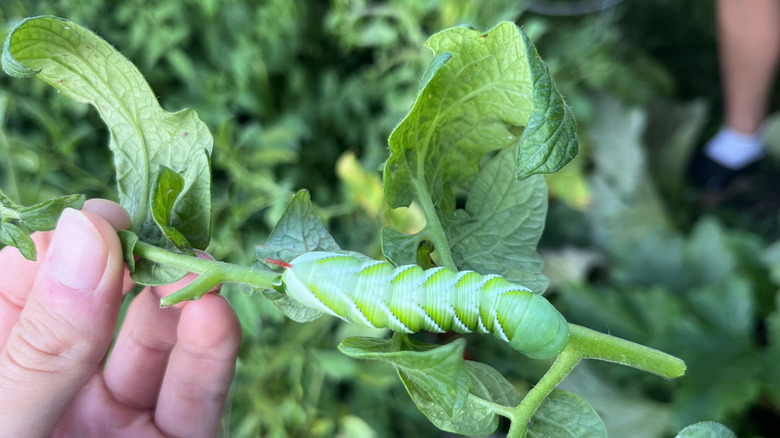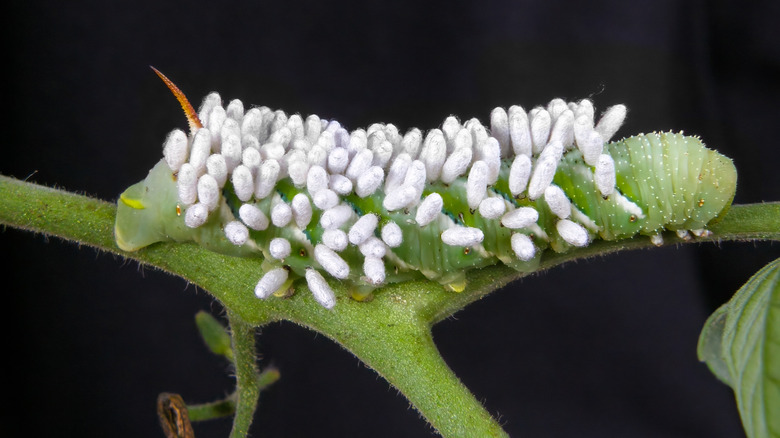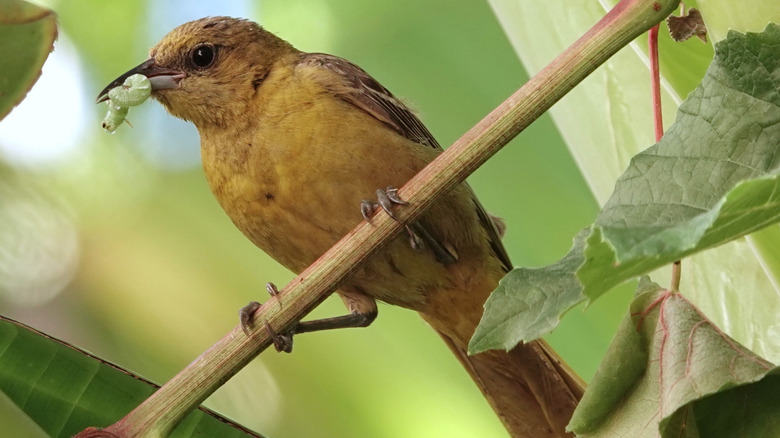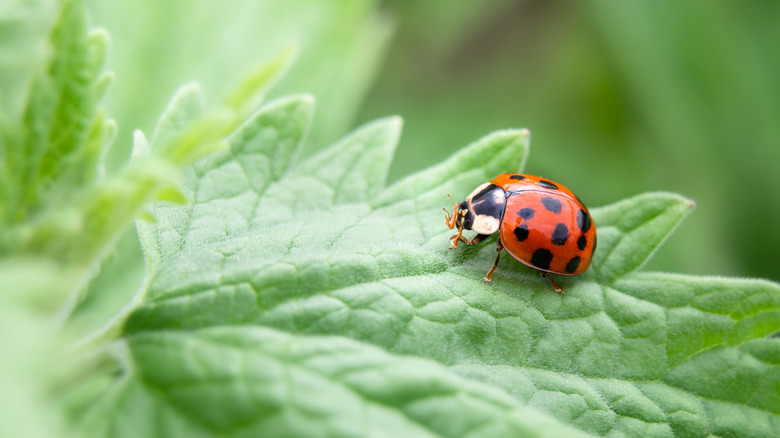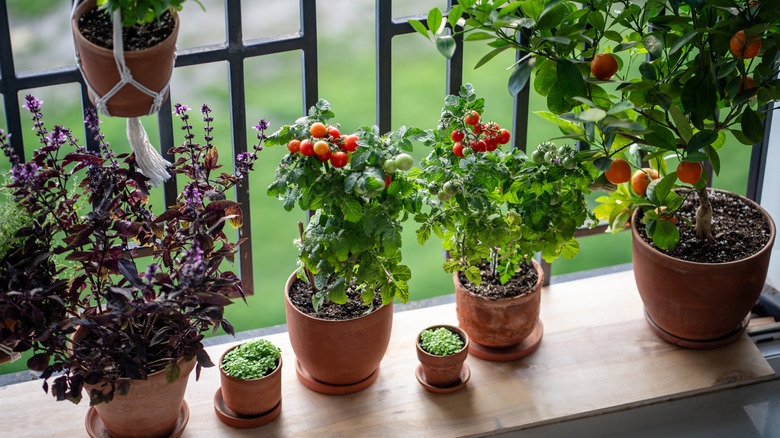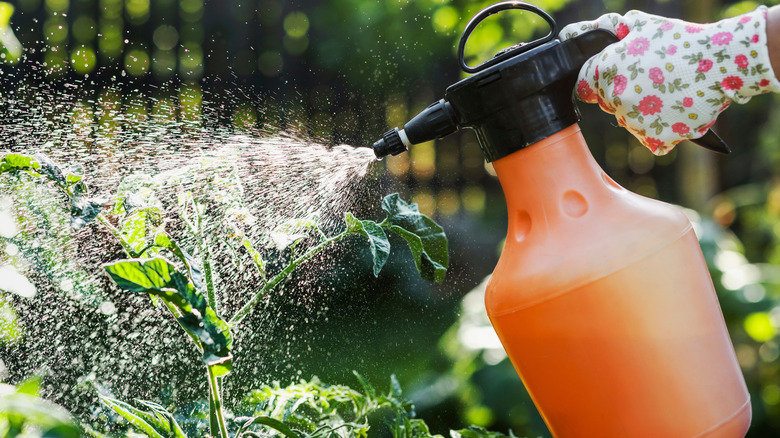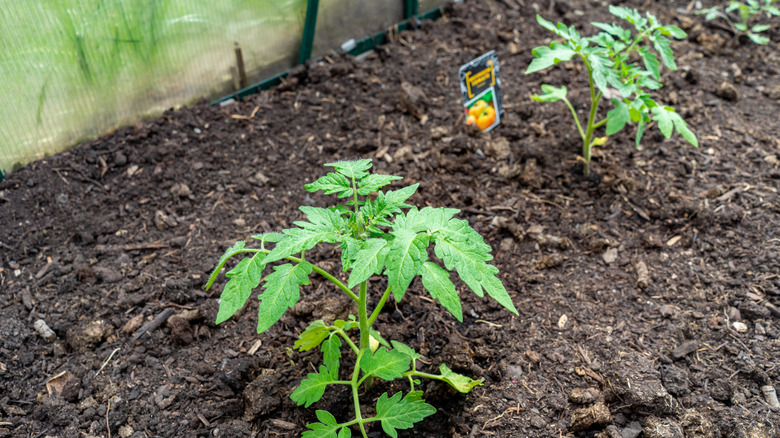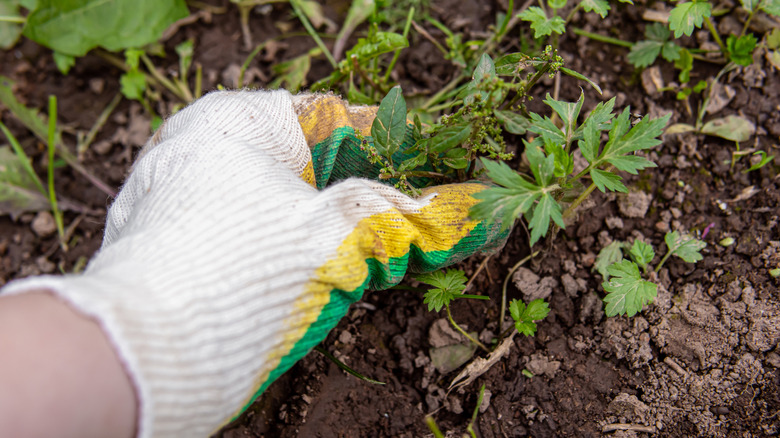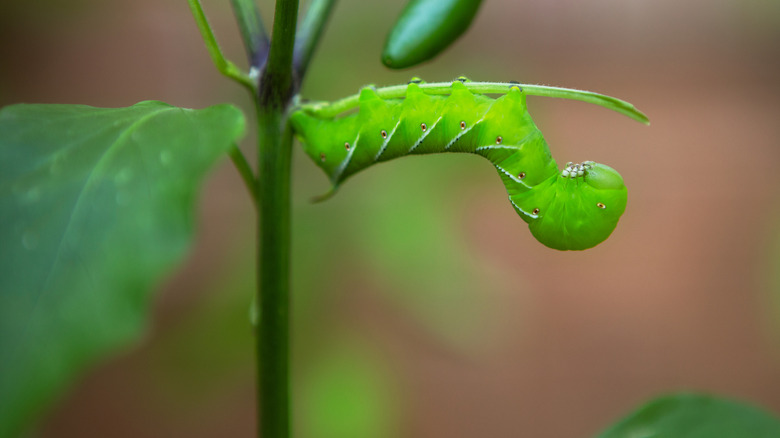11 Ways To Rid Your Garden Of Pesky Tomato Worms
When you're looking for easy fruits or veggies that beginning gardeners should grow, tomatoes are a solid choice. However, despite being easier to grow than some other fruits and vegetables, there is one annoying problem that you must be ready to deal with if you decide to plant tomatoes in your garden: tomato worms. Carrie Spoonemore, the co-founder of From Seed to Spoon and a contributor at Park Seed, helps us understand more about just what a tomato worm is. She explains, "Tomato worms, also called tomato hornworms, are big green caterpillars that feed on tomato plants. They can grow up to 4 inches long and have a little horn on their end."
Beyond their odd appearance, these worms are nothing to mess around with. Gail Pabst, the marketing director at National Garden Bureau, highlights the scope of the damage they can cause. "Only the larvae feed on tomato plants and they can consume large quantities of foliage in a short amount of time. One to two worms can defoliate a 5-foot tomato plant in less than three days," she cautions. Whether you are already dealing with a tomato worm problem or are trying to be proactive and protect your plants from the harm they cause, you've come to the right place. Through our interviews with Spoonemore and Pabst, we learned more about some of the best ways to keep these pests out of your garden and prevent them from devouring your tomato plants before you get to enjoy the juicy fruits of your labor.
Inspect your plants and garden closely for signs of tomato worms before they become a huge problem
It won't take long for a few tomato worms to turn into a full-blown infestation. And, as Gail Pabst shared above, even only one or two worms could remove all the foliage from a 5-foot plant in as little as three days. Because of this, you don't want to make the vegetable gardening mistake of assuming the pests won't be a problem or sitting by and waiting until you see signs that the hornworms have already descended onto your tomato plants. Carrie Spoonemore recommends being proactive. She says, "Check your tomato plants every day or two, especially in the morning or evening when the worms are more active."
However, spotting the worms themselves isn't always the easiest. Pabst notes the importance of looking for other signs of their presence instead of waiting until you realize that your plants have been stripped of their foliage. She says, "Besides seeing a lot of foliage damage, you can often see an accumulation of their large, black droppings (frass) on the leaves or ground, especially as the hornworms get larger."
Hand-pick the worms from your plants
If you want to prevent hornworms from standing between you and the best homemade pomodoro sauce, then it will be important to prevent them from doing damage to your plants as quickly as possible. According to Carrie Spoonemore, "Hand-picking is one of the most effective and natural ways to get rid of them." She recommends putting on some gardening gloves to protect your hands before picking any worms that you can find off of the plants. Before you go out to start picking, add some soapy water to the bottom of the bucket. Once you've picked the worms, you can drop them into the bucket to kill them without the need to use any potentially harmful chemicals.
One problem with hand-picking is how challenging it can be to spot the worms. Remember, because they are the same color as the leaves and stalks on the tomato plant, they can really blend in and remain hidden. Spoonemore offers a creative solution to this problem. She says, "Use a blacklight flashlight at night! Tomato worms glow under blacklight, making them easier to spot and remove after dark." Equip yourself with that same bucket of soapy water and a pair of gloves, and you'll be all set for your after hours hunting expedition.
Try to attract parasitic wasps, which will eat the hornworms, to your garden
You don't have to be the only one trying to clear up an infestation of hornworms. Instead, you can try to encourage some of their natural predators to visit your yard and let them take care of the problem for you. Parasitic wasps are one of these predators that you might want to attract. Gail Pabst explains, "Parasitic wasps lay their eggs under the skin of the hornworm, and when the larvae hatch, they eat the hornworm." If you find a hornworm that has small white cocoons from the parasitic wasps on its back, Pabst cautions against hand-picking it to remove it from the plants. She explains, "It will die and their bodies are a great source for increasing the beneficial wasp population."
For parasitic wasps to help you get rid of the pesky hornworms, you'll first need to encourage them to visit your yard. "To attract parasitic wasps, plant nectar-rich flowers like dill, parsley, yarrow, alyssum, or marigolds," says Carrie Spoonemore. She continues, "These flowers provide food for the adult wasps and keep them coming back to your garden."
Birds are another natural predator that you can welcome to your yard to control the population
Parasitic wasps aren't the only natural predator of tomato worms. As Carrie Spoonemore explains, "Birds also help by eating tomato worms." There are several types of birds that will eat caterpillars. A few of these include chickadees, orioles, sparrows, warblers, and nuthatches.
If you don't have a lot of birds that frequent your backyard, however, they won't be around to help remove the hornworms from your plants for you. There are a few things that you can do to make your backyard more appealing to birds to encourage them to visit and feast on the caterpillars. Adding a source of water, such as a fountain or a birdbath, is one of the top things you can do.
Birds will stop by for a refreshing splash or some water to drink — just be sure to clean the bird bath frequently to avoid making the birds sick. You should also consider shelter needs. Birds don't want to be left in a vulnerable position if a predator is nearby. Adding some nesting boxes or bushier plants can provide them with a greater sense of security. Another way to attract more birds is to add several feeders to your yard. Look for feeders with varying styles that are more likely to appeal to different types of birds. This will help you attract a more varied range of species.
Attract ladybugs and lacewings to feast on the small caterpillars and eggs
Carrie Spoonemore identifies two more beneficial predators that you might try to attract to your garden to keep tomato worms from destroying your plants. She says, "Lacewings and ladybugs eat the eggs and small larvae of hornworms." As soon as the larvae of these two insects hatch from their eggs, they'll start feasting on the hornworms, or any unhatched eggs that they can find. Beyond simply keeping hornworm numbers in check, Spoonemore shares, "These insects are especially helpful in keeping pest populations low."
Knowing how to attract these beneficial predators is key, once again, if you want to make sure they will visit your garden. Spoonemore recommends planting flowers that they like, including yarrow, sweet alyssum, and dill. Offering a water source and some shelter (such as a few shrubs or bushes in the vicinity of your tomato garden) can help.
Don't plant your tomatoes near other crops that attract similar pests
Did you know that there are several things that you should never plant with your tomatoes? If you plant them too close to another flower, fruit, or vegetable plant that attracts similar pests, you're just setting up a recipe for disaster. Carrie Spoonemore says, "Avoid planting tomatoes near corn, which can attract similar pests. Also avoid fennel, as it doesn't grow well near tomatoes." The pests can migrate back and forth between the tomatoes and the other plants, and you might find that you are left with virtually nothing to harvest.
Beyond the concern of pests from other plants eating your tomato plants, you also need to worry about the hornworms eating the other crops in your garden. Just because they are called tomato worms, you shouldn't assume that they exclusively munch on tomato plants. According to Gail Pabst, "They also can feed on eggplants, potatoes, and pepper plants." So, you'll want to keep these plants far away from your tomatoes.
Do choose beneficial companion plants for your tomatoes to deter the pests
While there are some plants that you don't want anywhere near your tomatoes in the garden, there are others that you should consider planting close by. Companion planting is a gardening strategy that relies on grouping certain crops together that will help one another stay healthy and grow. These groupings are determined based on the specific characteristics of the plants and how they may be able to support the growth of the other ones, such as by deterring pests, enriching the soil, or providing protection against the elements.
Carrie Spoonemore says, "Good companion plants for tomatoes include basil, which helps keep worms away and can improve the flavor of tomatoes." She also recommends planting marigolds by your tomatoes to eliminate pests with the stronger scent of the flower. One more companion plant that Spoonemore recommends is Borage. She explains that it is a "good option that brings in helpful bugs and may discourage tomato worms."
Choose safe insecticides for the plants
Using insecticides is an option if you're having a difficult time ridding your plants of hornworms. However, there are a few considerations to keep in mind before spraying the garden. For one, you should keep your expectations realistic. According to Gail Pabst, "They work best on younger, smaller caterpillars." So, you may not completely eliminate the infestation. But, it should be easier to identify and hand-pick all of the larger caterpillars once the smaller ones are taken care of.
Additionally, since we're talking about an edible crop, it is imperative to choose safe insecticides. Carrie Spoonemore recommends sticking with mostly natural or organic options for this reason. One she recommends is Bacillus thuringiensis (Bt). She explains that it "is a natural bacteria that targets caterpillars like hornworms but doesn't harm people or pollinators." Neem oil is another natural insecticide that Spoonemore highlights. The oil works by messing with the hormone system of the tomato worms. This can inhibit their ability to grow, mate, lay eggs, and more. It is also known to make eating more difficult for hornworms and other insects. If you're going to try neem oil with your tomato plants, Spoonemore offers a word of caution. She says, "It should be used with care during cooler times of day to avoid damaging the plants."
When choosing an insecticide to use with your tomato plants, it is important to do so very carefully. This is especially true if you're planning to purchase a commercially available option. Spoonemore explains, "Some insecticides are unsafe because they can harm bees, birds, or leave chemical residue on the tomatoes you eat. Always check the label to make sure it's safe for edible plants."
Use floating row covers to protect the plants
When your tomato plants are just getting established, they are more prone to damage from the hornworms. If you want to give these plants time to strengthen and become more established in the garden, Carrie Spoonemore recommends placing floating row covers over them. If you are not familiar with row covers, they are literal covers designed to protect the plants beneath them. They are typically made from a material such as polyester or woven plastic. While the covering will still allow water to reach the plants, Spoonemore explains that it also "keeps adult moths from laying eggs on your tomatoes."
However, you won't be able to leave the row covers on indefinitely. If you do, the plants will never be able to produce tomatoes since the covers will also block bees, butterflies, and other beneficial pollinators. To avoid this problem, Spoonemore says, "Be sure to remove the covers when flowers bloom so pollinators can get in."
Maintain a clean garden to eliminate hiding places
Keeping your garden tidy is important for a variety of reasons. Beyond simply creating an eyesore, a messy garden can also increase the risk of a hornworm infestation. To minimize the chances of this occurring, Carrie Spoonemore says, "Remove weeds and tidy up old leaves and fallen fruit to get rid of places where pests might hide or lay eggs."
While a clean garden won't prevent the adult moths from laying their eggs, it will make it much easier for you to spot signs of an infestation earlier, find the tomato worms, and remove them from your plants. If your garden is a mess, this might not be the case, and you could end up missing out on the chance to remove the caterpillars before they completely take over.
Consider moving the hornworms to a single plant to let them turn into a beneficial pollinator
Despite the problems that hornworms can cause, there are a few reasons to reconsider completely removing them from your garden or killing them. According to Gail Pabst, "That hungry caterpillar turns into a lovely hawk moth, a nocturnal pollinator. If you have seen one, they are beautiful!" By killing the caterpillars, you're preventing them from turning into a beneficial pollinator that can support the health of many different plants around your home and neighborhood.
However, just because you might want to reconsider killing them, it doesn't mean that you have to let the caterpillars destroy all of your tomato plants. Pabst says, "I leave my tomato hornworms. I move them to one plant to feast on or move them to another plant in the nightshade family." This way, they won't destroy your entire crop, but you'll still be able to help add more hawk moth pollinators to the world.
